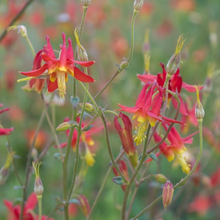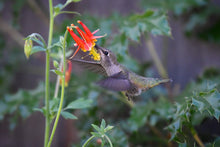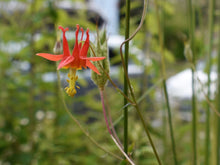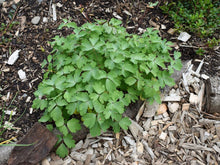
Aquilegia formosa
Red columbine (or western columbine) is a stunning wildflower that will beckon neighborhood hummingbirds, butterflies and pest-eating insects to your garden. The nodding blossoms consist of dramatically-spurred red to orange sepals surrounding yellow petals blooming late spring to late summer, followed by seed heads in the late summer and fall that are preferred by finches and other songbirds. Overall, native columbine is an outstanding and attractive addition to any wildlife garden.
- Plant type/canopy layer: deciduous, perennial, herbaceous plant
- Size at maturity: 36" tall, 12-24" wide
- Light requirements: part-sun/part-shade
- Moisture requirements: moist soil, prefers well-drained
- Bloom time: April - August (April - July in the Portland Metro area)
- Growth rate/ease: moderate growth rate, easy to grow.
- Wildlife support: flowers are a nectar source for hummingbirds, adult butterflies, bees and other insect pollinators; nature seed heads are consumed by finches and at least six other species of local birds, as well as small mammal; overall plant attracts and supports beneficial and other pest eating insects and is a caterpillar host plant and larval food source for native butterflies and moths including the Orange Tortrix Moth.
- Native habitat/range: native to and common in many habitats, including chaparral, oak woodland, and mixed-evergreen or coniferous forest of the western North America, from Alaska to Baja California and eastward to Montana and Wyoming. Portland Plant List - yes.
- Special features: from pollinators and other beneficial insects to songbirds, it's a wildlife magnet; deer resistant; ethnobotanically it was historically consumed by indigenous peoples only as a famine food and used medicinally to treat a variety of maladies, though it is rarely used in herbalism today; landscape uses include raingardens, pollinator gardens, moist meadowscapes and woodland garden edges
Gardening with Red Columbine: This stunning species is an excellent option for partially-shady, moist areas with compost-rich, well-drained soils - such as a raingarden, moist meadowscape or brighter edges of a woodland garden. Areas near vegetable beds can be excellent micro climates as well, since supplemental moisture is already being provided during the summer drought. Generally, the more sun it receives, the more moisture it will require.
Excellent companion plants include Douglas fir (Pseudotsuga menziesii), meadowrue (Thalictrum occidental), yellow monkeyflower (Mimulus guttatus), western azalea (Rhododendron occidentale), and evergreen huckleberry (Vaccinum ovatum). This species can self-sow, but it is not overly aggressive and its spread is usually welcomed.
When overly stressed by drought and where there is not good airflow, it is susceptible to powdery mildew on its leaves, especially late in the season as it's already dying back. If this occurs, consider transplanting to a more favorable area or simply pinch off and dispose of affected leaves in your curbside roll bin - or do nothing and know it will return just fine next spring.
Photo Credits 1, 2: Tara Lemezis, Tiny Seed Photography
Photo Credits 3, 4: Nikkie West, Sparrowhawk Native Plants







